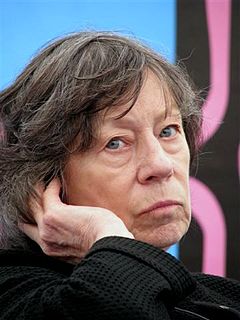Related Research Articles

Meshes of the Afternoon is a 1943 American short experimental film directed by and starring wife-and-husband team Maya Deren and Alexander Hammid. The film's narrative is circular and repeats several motifs, including a flower on a long driveway, a key falling, a door unlocked, a knife in a loaf of bread, a mysterious Grim Reaper–like cloaked figure with a mirror for a face, a phone off the hook and an ocean. Through creative editing, distinct camera angles, and slow motion, the surrealist film depicts a world in which it is more and more difficult to catch reality.

Roland Gérard Barthes was a French literary theorist, essayist, philosopher, critic, and semiotician. Barthes's ideas explored a diverse range of fields and he influenced the development of many schools of theory, including structuralism, semiotics, social theory, design theory, anthropology, and post-structuralism. He was particularly known for developing and extending the field of semiotics through the analysis of a variety of sign systems, mainly derived from Western popular culture.
New Wave is a French art film movement which emerged in the late 1950s. The movement was characterized by its rejection of the era's traditional filmmaking conventions in favor of experimentation and a spirit of iconoclasm. New Wave filmmakers explored new approaches to editing, visual style, and narrative, as well as engagement with the social and political upheavals of the era, often making use of irony or exploring existential themes. The New Wave is often considered one of the most influential movements in the history of cinema.

Laura Mulvey is a British feminist film theorist. She was educated at St Hilda's College, Oxford. She is currently professor of film and media studies at Birkbeck, University of London. She worked at the British Film Institute for many years before taking up her current position.
Experimental film, experimental cinema or avant-garde cinema is a mode of filmmaking that rigorously re-evaluates cinematic conventions and explores non-narrative forms and alternatives to traditional narratives or methods of working. Many experimental films, particularly early ones, relate to arts in other disciplines: painting, dance, literature and poetry, or arise from research and development of new technical resources.

Eros + Massacre is a Japanese black-and-white film released in 1969. It was directed by Yoshishige Yoshida, who wrote it in cooperation with Masahiro Yamada. It is the first film in Yoshida's trilogy of Japanese radicalism, followed by Heroic Purgatory (1970) and Coup d'Etat (1973).

The Fright of Real Tears: Krzysztof Kieślowski Between Theory and Post-Theory is a 2001 book by the Slovenian philosopher Slavoj Žižek which uses free associative film interpretation to tangentially examine the films of Polish director Krzysztof Kieślowski while avoiding the debate between cognitive film theory and psychoanalytic film theory. It was published by the British Film Institute in 2001.
Soviet montage theory is an approach to understanding and creating cinema that relies heavily upon editing. It is the principal contribution of Soviet film theorists to global cinema, and brought formalism to bear on filmmaking.
French impressionist cinema refers to a group of French films and filmmakers of the 1920s.
Noël Burch is an American film theorist and movie maker who moved to France at a young age. Burch is known for his contribution to terms commonly used by film scholars and for his theories compiled in books such as Theory of Film Practice or La lucarne de L'Infini.

National cinema is a term sometimes used in film theory and film criticism to describe the films associated with a specific nation-state. Although there is little relatively written on theories of national cinema it has an irrefutably important role in globalization. Film provides a unique window to other cultures, particularly where the output of a nation or region is high.
Borderline is a 1930 film, written and directed by Kenneth Macpherson and produced by the Pool Group in Territet, Switzerland. The silent film, with English inter-titles, is primarily noted for its handling of the contentious issue of inter-racial relationships, using avant-garde experimental film-making techniques, and is today very much part of the curriculum of the study of modern cinematography.
Documentary mode is a conceptual scheme developed by American documentary theorist Bill Nichols that seeks to distinguish particular traits and conventions of various documentary film styles. Nichols identifies six different documentary 'modes' in his schema: poetic, expository, observational, participatory, reflexive, and performative. While Nichols' discussion of modes does progress chronologically with the order of their appearance in practice, documentary film often returns to themes and devices from previous modes. Therefore, it is inaccurate to think of modes as historical punctuation marks in an evolution towards an ultimate accepted documentary style. Also, modes are not mutually exclusive. There is often significant overlapping between modalities within individual documentary features. As Nichols points out, "the characteristics of a given mode function as a dominant in a given film…but they do not dictate or determine every aspect of its organization."

In the early history of cinema, trick films were short silent films designed to feature innovative special effects.
Cat's Cradle is an experimental short film by Stan Brakhage, produced in 1959. The film was described by Brakhage as "sexual witchcraft involving two couples and a 'medium' cat."
The film-poem is a label first applied to American avant-garde films released after World War II. During this time, the relationship between film and poetry was debated. James Peterson in Dreams of Chaos, Visions of Order said, "In practice, the film poem label was primarily an emblem of the avant-garde's difference from the commercial narrative film." Peterson reported that in the 1950s, overviews of avant-garde films "generally identified two genres: the film poem and the graphic cinema". By the 1990s, the avant-garde cinema encompassed the term "film-poem" in addition to different strains of filmmaking. Film-poems are considered "personal films" and are seen "as autonomous, standing apart from traditions and genres". They are "an open, unpredictable experience" due to eschewing extrinsic expectations based on commercial films. Peterson said, "The viewer's cycles of anticipation and satisfaction derive primarily from the film's intrinsic structure." The film-poems are personal as well as private: "Many film poems document intimate moments of the filmmaker's life."
Non-narrative film is an aesthetic of cinematic film that does not narrate, or relate "an event, whether real or imaginary". It is usually a form of art film or experimental film, not made for mass entertainment.
Riddles of the Sphinx is a 1977 film written and directed by Laura Mulvey and Peter Wollen and starring Dinah Stabb, Merdelle Jordine and Riannon Tise. It was produced by the British Film Institute. The electronic score is from Mike Ratledge of Soft Machine.
In feminist theory, the male gaze is the act of depicting women and the world, in the visual arts and in literature, from a masculine, heterosexual perspective that presents and represents women as sexual objects for the pleasure of the male viewer. In the visual and aesthetic presentations of narrative cinema, the male gaze has three perspectives: (i) that of the man behind the camera, (ii) that of the male characters within the film's cinematic representations; and (iii) that of the spectator gazing at the image.
Stella F. Simon was an American photographer, director and cinematographer who worked in both Germany and the United States. In 1928, she finished her only film, Hands: The Life and Love of a Gentle Sex, which is an avant-garde feminist film with imagery drawn from Europe and North America.
References
- ↑ Noël Burch (1979). To the Distant Observer: Form and Meaning in Japanese Cinema . Berkeley: University of California Press.
- ↑ Noël Burch (1986). "Primitivism and the Avant-Gardes: A Dialectical Approach" in Narrative-Apparatus-Ideology, ed. Phil Rosen. New York: Columbia UP. p. 491
- Bordwell, David (1997). On the History of Film Style. Cambridge, Mass.: Harvard University Press. Chapter 4.
- Burch, Noël (1973). Theory of Film Practice, trans. Helen R. Lane. New York: Praeger.